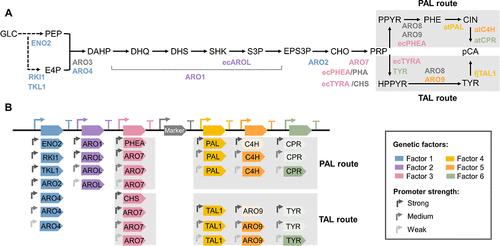当前位置:
X-MOL 学术
›
ACS Synth. Biol.
›
论文详情
Our official English website, www.x-mol.net, welcomes your feedback! (Note: you will need to create a separate account there.)
Machine Learning-Guided Optimization of p-Coumaric Acid Production in Yeast
ACS Synthetic Biology ( IF 4.7 ) Pub Date : 2024-03-28 , DOI: 10.1021/acssynbio.4c00035 Sara Moreno-Paz 1 , Rianne van der Hoek 2 , Elif Eliana 1 , Priscilla Zwartjens 2 , Silvia Gosiewska 2 , Vitor A. P. Martins dos Santos 3 , Joep Schmitz 2 , Maria Suarez-Diez 1
ACS Synthetic Biology ( IF 4.7 ) Pub Date : 2024-03-28 , DOI: 10.1021/acssynbio.4c00035 Sara Moreno-Paz 1 , Rianne van der Hoek 2 , Elif Eliana 1 , Priscilla Zwartjens 2 , Silvia Gosiewska 2 , Vitor A. P. Martins dos Santos 3 , Joep Schmitz 2 , Maria Suarez-Diez 1
Affiliation

|
Industrial biotechnology uses Design–Build–Test–Learn (DBTL) cycles to accelerate the development of microbial cell factories, required for the transition to a biobased economy. To use them effectively, appropriate connections between the phases of the cycle are crucial. Using p-coumaric acid (pCA) production in Saccharomyces cerevisiae as a case study, we propose the use of one-pot library generation, random screening, targeted sequencing, and machine learning (ML) as links during DBTL cycles. We showed that the robustness and flexibility of the ML models strongly enable pathway optimization and propose feature importance and Shapley additive explanation values as a guide to expand the design space of original libraries. This approach allowed a 68% increased production of pCA within two DBTL cycles, leading to a 0.52 g/L titer and a 0.03 g/g yield on glucose.
中文翻译:

机器学习引导优化酵母中对香豆酸的生产
工业生物技术利用设计-构建-测试-学习 (DBTL) 循环来加速微生物细胞工厂的开发,这是向生物经济转型所需的。为了有效地使用它们,周期各阶段之间的适当连接至关重要。以酿酒酵母中对香豆酸 (pCA) 的生产作为案例研究,我们建议使用一锅文库生成、随机筛选、靶向测序和机器学习 (ML) 作为 DBTL 循环期间的环节。我们表明,ML 模型的稳健性和灵活性极大地支持路径优化,并提出特征重要性和 Shapley 附加解释值作为扩展原始库设计空间的指南。这种方法使 pCA 产量在两个 DBTL 循环内增加了 68%,导致滴度为 0.52 g/L,葡萄糖产量为 0.03 g/g。
更新日期:2024-03-28
中文翻译:

机器学习引导优化酵母中对香豆酸的生产
工业生物技术利用设计-构建-测试-学习 (DBTL) 循环来加速微生物细胞工厂的开发,这是向生物经济转型所需的。为了有效地使用它们,周期各阶段之间的适当连接至关重要。以酿酒酵母中对香豆酸 (pCA) 的生产作为案例研究,我们建议使用一锅文库生成、随机筛选、靶向测序和机器学习 (ML) 作为 DBTL 循环期间的环节。我们表明,ML 模型的稳健性和灵活性极大地支持路径优化,并提出特征重要性和 Shapley 附加解释值作为扩展原始库设计空间的指南。这种方法使 pCA 产量在两个 DBTL 循环内增加了 68%,导致滴度为 0.52 g/L,葡萄糖产量为 0.03 g/g。



























 京公网安备 11010802027423号
京公网安备 11010802027423号